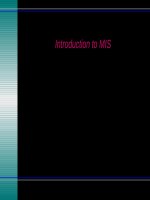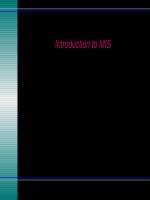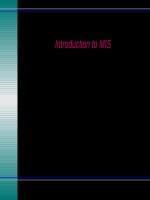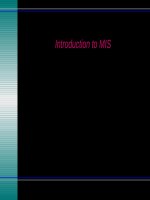Lecture Management information systems: Solving business problems with information technology – Chapter 7
Bạn đang xem bản rút gọn của tài liệu. Xem và tải ngay bản đầy đủ của tài liệu tại đây (1.21 MB, 50 trang )
Introduction to MIS
Chapter 7
Integration of Information
Copyright © 1998-2002 by Jerry Post
Introduction to MIS
1
Integration
Everyone in the
company
including
managers,
salespeople,
and engineers
need access to
the same data
across the
organization.
Introduction to MIS
2
Outline
Business Integration
Enterprise Resource Planning
Customer Relationship Management
Workgroups
Data Warehouses
Integration with Diversity
Cases: Automobiles
Appendix: Microsoft NetMeeting
Introduction to MIS
3
File: DeptStore2000.mdb File: C07E06.xls
Business Integration Example
Daily Sales Report
February 7, 2004
Department Item#
House
1153
5543
W.Clothing 5563
7765
9986
Shoes
1553
6673
Q-sold
52
13
1
4
2
2
1
Price
2.95
0.59
87.32
54.89
15.69
65.79
29.39
Total Sales:
Value
153.40
7.67
87.32
219.56
31.38
131.58
29.39
660.30
Commissions
Emp#
1143
2895
4462
7893
9963
Name
Jones
Brown
Smith
Torrez
Cousco
Introduction to MIS
Dept
House
M.Clothing
W.Clothing
Shoes
M.Clothing
Returned Merchandise Log
February 7, 2004
Item#
1153
3353
4453
8878
Q
3
6
2
1
Total
12
Price
2.95
27.59
15.95
24.95
Value
8.85
165.54
31.90
24.95
231.24
February 7, 2004
Sales
543.95
775.35
1,544.52
876.93
589.47
Rate
5%
4%
5%
6%
5%
Amount
27.20
31.01
77.23
52.62
29.47
4
Integrated Report Example
Weekly Sales Analysis
2/01/04 - 2/07/04
Manager comments are written in the first ten pages,
along with comments on special events.
Department Analysis
Dept
Sales
Returns
Commissions
House
4,113.58
25.35
205.68
W.Clothing 54,221.92
998.52
3,024.64
M.Clothing 28,664.48
356.24
1,421.58
Shoes
10,225.31
853.47
592.36
Total:
97,225.29 2,233.58
5,244.26
Net
3,882.55
50,198.76
26,886.66
8,779.48
89,747.45
Sales & Net Sales
60000
40000
20000
0
House
Introduction to MIS
W. Cloth. M. Cloth.
Shoes
5
1960s & 1970s MIS Pieces
Accounting:
Integrated Data
Separate
Reports
Marketing:
Forecasts
Production:
MRP
Purchasing:
Orders
Introduction to MIS
Sales:
Orders
6
Sales
Terminals
Sales
Terminals
sales
data
Central
computer:
create reports
sales
data
Management
Manager:
Integrate, graph
analyze
weekly reports
Secretary:
type & revise
1990s
query
sales
data
Introduction to MIS
Management
3 reports
Central
Manager:
(printed)
computer:
Integrate, graph
create reports
analyze
Sales
Terminals
Sales
Terminals
3 reports
(printed)
1980s
Sales
Terminals
Sales
Terminals
Changes
1970s
DBMS:
On-line data
data
weekly reports
personal computer
Management
Personal Computer
Weekly reports &
ad hoc queries
(applications)
7
Integration in 2000s
Management
Sales
Terminals
Sales
Terminals
query
sales
data
DBMS
data
Suppliers
Production/
Service
Executive Information
System
Personal Computer
Or PDA
Or Browser
Enterprise Resource
Planning
Banks
Introduction to MIS
8
Business Integration
Design feasibility
& production costs
Design &
Engineering
Designs and Quality
product planning
planning
& monitoring
Marketing
Manufacturing
planning
& monitoring
Vendors
Distribution
Purchasing Demand-pull Mass
Customization
Just-in-Time
partnerships
& joint
development
Introduction to MIS
Administration & Management
HRM Accounting Finance
Quality control
& Custom orders
MIS
Customers
Quick
Response
partnerships
& joint
development
9
ERP Integration
Headquarters
(France)
Subsidiary
(Spain)
Database
Use inventory item.
Deduct quantity.
Update inventory value.
Check for reorder point.
Order new item through EDI.
Update Accounts payable.
Financial data
General ledger
Payroll
…
Weekly financial status.
Cash flow.
Budget versus actual cost.
Introduction to MIS
Database
Manufacturing
Product details
Inventory
…
Project cost report.
Daily production report.
10
Enterprise Resource Planning
Integrated systems
Examples
SAP
Peoplesoft
Lawson
J.D. Edwards
Basic features included
Accounting
Purchasing
HRM
Investment management
International environment
Multiple currencies
Multiple languages
Procedures and practices
Follows local (national) rules
Follows consolidation rules
Example
Introduction to MIS
U.S. firm with European
subsidiaries.
Data is entered once
European reports are
generated for subsidiaries
following local rules
Results are converted and
consolidated to U.S. firm
following international and
U.S. rules
11
SAP
Based in Germany, now
worldwide
Support for international
transactions and
multinational firms
Runs on multiple database
and hardware platforms
Can handle large and small
companies
Expensive, but price is
relative.
Introduction to MIS
Financials
Logistics
Human resource
management
12
Investment
planning/budgeting/control
Depreciation
forecast/simulation/calculate
Controls
General ledger
Accounts receivable/payable
Special ledgers
Fixed assets
Legal consolidation
Investment Management
SAP Financials
Financial Accounting
Treasury
Cash management
Treasury management
Market risk management
Funds management
Enterprise Control
Overhead cost
Activity based costing
Product cost
Profitability analysis
Introduction to MIS
Executive information
system
Business planning and
budgeting
Profit center accounting
Consolidation
13
SAP Logistics
Purchasing
Materials management
Manufacturing
Warehousing
Quality management
Plant maintenance
Service management
Sales
Distribution
Product data management
Sales and distribution
Introduction to MIS
Master data management
Design and change process
Product structure
Development projects
Sales activities
Sales order management
Shipping and transportation
Billing
Sales information system
14
SAP Logistics
Production planning and
control
Production planning
Material requirements
planning
Production control and
capacity planning
Costing
Order information system
Shop floor information
system
Introduction to MIS
Project system
Work breakdown structures
Network planning
techniques, milestones
Cost, revenue, financial,
schedule, and resource
management
Earned value calculation
Project information system
15
Purchasing
Inventory management
Warehouse management
Invoice verification
Inventory controlling
Purchasing information
system
Quality management
SAP Logistics
Materials management
Quality planning
Quality inspections
Quality control
Quality notifications and
certificates
Quality management
information system
Introduction to MIS
Plant maintenance
Structuring technical
systems
Maintenance resource
planning
Maintenance planning
System for technical and
cost accounting data
Maintenance information
system
16
SAP Logistics
Service management
Customer installed base
administration
Service contract
management
Call management
Billing
Service information system
Introduction to MIS
Integration
When the clerk enters a sale,
bills are generated
automatically (mail, fax, or
EDI).
Sales and revenue are
instantly updated in financial
and control modules.
The sales information
system and EIS provide
various up-to-date views and
reports.
17
SAP HRM
Personnel management
Payroll accounting
Organization structure
Staffing schedules
Job descriptions
Planning scenarios
Personnel cost planning
Introduction to MIS
Gross/net accounting
History function
Dialog capability
Multi-currency capability
International solutions
Time management
Organizational management
HR master data
Personnel administration
Information systems
Recruitment
Travel management
Benefits administration
Salary administration
Shift planning
Work schedules
Time recording
Absence determination
Error handling
18
SAP HRM
Personnel development
Career and succession
planning
Profile comparisons
Qualifications assessments
Additional training
determination
Training and event
management
Introduction to MIS
Other features
SAP Business workflow
Internet scenarios
Employee self-service
19
SAP Integration
Financial general ledger
holds all base totals.
Sub-ledgers are defined for
important accounts
All transactions automatically
flow through
Accounts payable
Manufacturing
User-defined
etc.
Including currency
conversions
Special rules can be defined
Introduction to MIS
Simple example
Manufacturing uses an item
from inventory
The quantity on hand is
updated
The inventory value is
automatically changed
On any sub-ledgers
On the general ledger
Reports are generated in any
currency
New orders and payments
can be generated through
EFT.
20
Customer Relationship Management
Multiple Contact Points
Feedback, Individual Needs, and Cross Selling
The goal is to provide a single, integrated view of all customer
activity, available to all employees who interact with the
customer.
Having better information enables workers to provide better
service, meet the individual needs of each customer.
Introduction to MIS
21
Workgroups
Computers are increasingly used to support teamwork and workgroups.
Data, comments, and analysis are created and shared through networks
of computers.
Introduction to MIS
22
SharePoint: Discussion
Introduction to MIS
23
SharePoint: Survey
Create a new survey
Add questions
Introduction to MIS
Multiple Choice
Open ended/text
Selection Lists
Run the survey
Graph the results
24
Tracking Changes and Adding Discussions
Introduction to MIS
25









